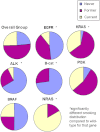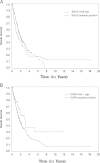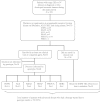Implementing multiplexed genotyping of non-small-cell lung cancers into routine clinical practice
- PMID: 22071650
- PMCID: PMC3493130
- DOI: 10.1093/annonc/mdr489
Implementing multiplexed genotyping of non-small-cell lung cancers into routine clinical practice
Abstract
Background: Personalizing non-small-cell lung cancer (NSCLC) therapy toward oncogene addicted pathway inhibition is effective. Hence, the ability to determine a more comprehensive genotype for each case is becoming essential to optimal cancer care.
Methods: We developed a multiplexed PCR-based assay (SNaPshot) to simultaneously identify >50 mutations in several key NSCLC genes. SNaPshot and FISH for ALK translocations were integrated into routine practice as Clinical Laboratory Improvement Amendments-certified tests. Here, we present analyses of the first 589 patients referred for genotyping.
Results: Pathologic prescreening identified 552 (95%) tumors with sufficient tissue for SNaPshot; 51% had ≥1 mutation identified, most commonly in KRAS (24%), EGFR (13%), PIK3CA (4%) and translocations involving ALK (5%). Unanticipated mutations were observed at lower frequencies in IDH and β-catenin. We observed several associations between genotypes and clinical characteristics, including increased PIK3CA mutations in squamous cell cancers. Genotyping distinguished multiple primary cancers from metastatic disease and steered 78 (22%) of the 353 patients with advanced disease toward a genotype-directed targeted therapy.
Conclusions: Broad genotyping can be efficiently incorporated into an NSCLC clinic and has great utility in influencing treatment decisions and directing patients toward relevant clinical trials. As more targeted therapies are developed, such multiplexed molecular testing will become a standard part of practice.
Figures




Comment in
-
Screening: Smile, they're taking a SNaPshot of your cancer-causing genes.Nat Rev Clin Oncol. 2011 Dec 6;9(1):6. doi: 10.1038/nrclinonc.2011.184. Nat Rev Clin Oncol. 2011. PMID: 22143141 No abstract available.
References
-
- Druker BJ, Sawyers CL, Kantarjian H, et al. Activity of a specific inhibitor of the BCR-ABL tyrosine kinase in the blast crisis of chronic myeloid leukemia and acute lymphoblastic leukemia with the Philadelphia chromosome. N Engl J Med. 2001;344(14):1038–1042. - PubMed
-
- Demetri GD, von Mehren M, Blanke CD, et al. Efficacy and safety of imatinib mesylate in advanced gastrointestinal stromal tumors. N Engl J Med. 2002;347(7):472–480. - PubMed
-
- Lynch TJ, Bell DW, Sordella R, et al. Activating mutations in the epidermal growth factor receptor underlying responsiveness of non-small-cell lung cancer to gefitinib. N Engl J Med. 2004;350(21):2129–2139. - PubMed
-
- Paez JG, Janne PA, Lee JC, et al. EGFR mutations in lung cancer: correlation with clinical response to gefitinib therapy. Science. 2004;304(5676):1497–1500. - PubMed
MeSH terms
Substances
Grants and funding
LinkOut - more resources
Full Text Sources
Other Literature Sources
Medical
Research Materials
Miscellaneous

